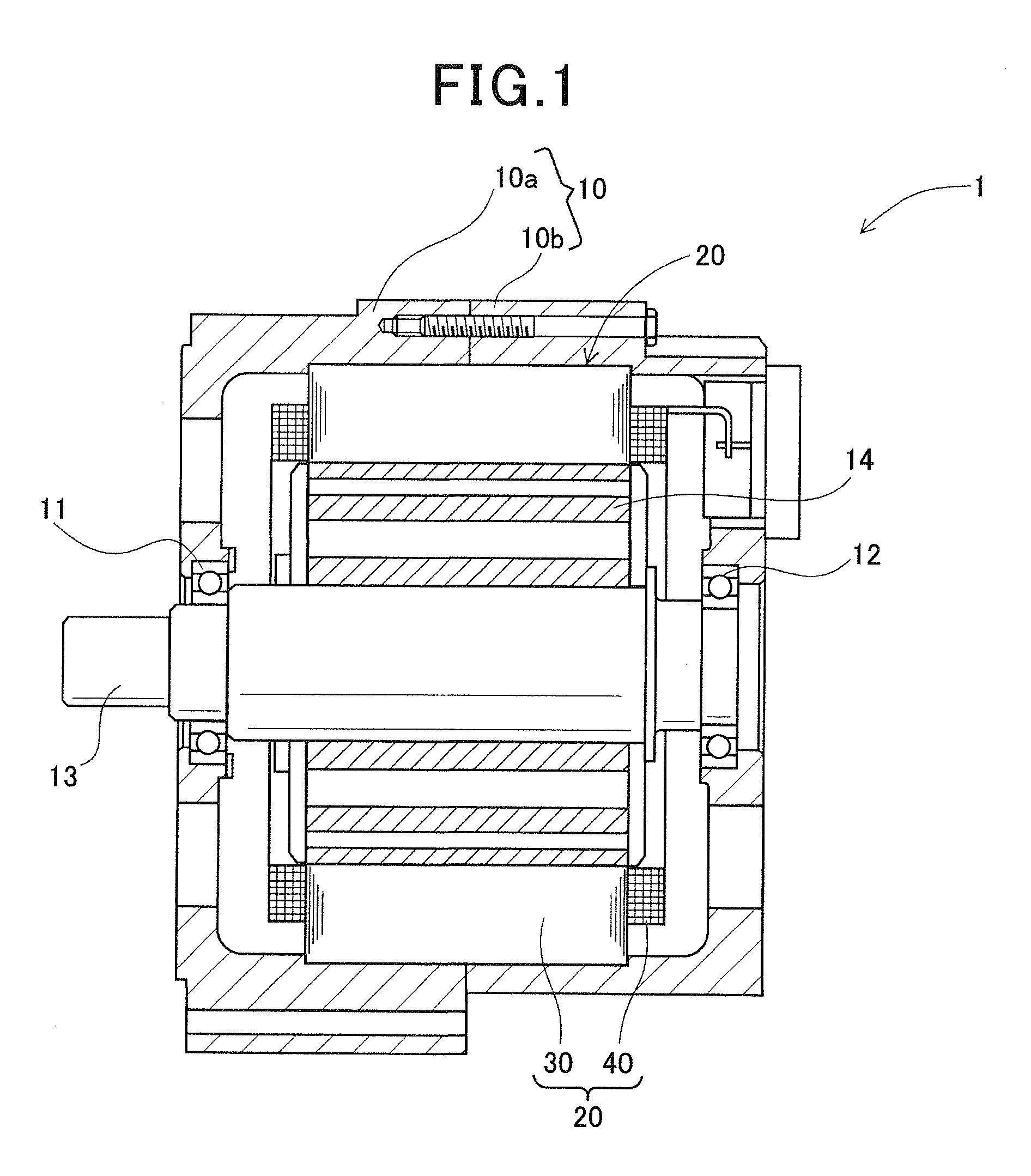Electric rotating machine
a technology of rotating machines and rotating coils, which is applied in the direction of dynamo-electric components, ac commutators, dynamo-electric machines, etc., can solve the problem of no bridging wires, and achieve the effect of minimizing the negative mutual inductance therebetween, reducing the total inductance of the stator coil, and weakening the magnetic coupling
- Summary
- Abstract
- Description
- Claims
- Application Information
AI Technical Summary
Benefits of technology
Problems solved by technology
Method used
Image
Examples
first embodiment
[0071]FIG. 1 shows the overall configuration of an electric rotating machine 1 according to a first embodiment. The electric rotating machine 1 is designed to be used in a motor vehicle to function as an electric motor.
[0072]As shown in FIG. 1, the electric rotating machine 1 includes a housing 10, a rotor 14 and a stator 20. The housing 10 is comprised of a pair of substantially cup-shaped housing pieces 10a and 10b which are jointed together at the open ends thereof. The housing 10 has a pair of bearings 11 and 12 mounted therein, via which a rotating shaft 13 is rotatably supported by the housing 10. The rotor 14 is received in the housing 10 and fixed on the rotating shaft 13. The stator 20 is fixed in the housing 10 so as to surround the radially outer periphery of the rotor 14.
[0073]The rotor 14 includes a plurality of permanent magnets that are embedded at predetermined positions in the rotor 14. The permanent magnets form a plurality of pairs of N and S magnetic poles on the...
experiment 1
[Experiment 1]
[0105]This experiment has been conducted to verify the effect of lowering the maximum phase-to-phase voltage of the stator coil 40 according to the first embodiment.
[0106]Specifically, in the experiment, an electric rotating machine was used in which: the stator core had two single-phase slots per phase winding of the stator coil and per magnetic pole of the rotor; and the phase windings of the stator coil were wave-wound on the stator core so as to be radially stacked in six layers in each slot of the stator core. Moreover, with the electric rotating machine, three different stator configurations were realized by changing the sequence of electrically connecting different sections of the phase windings of the stator coil.
[0107]The first configuration was the conventional one as shown in FIG. 27A. The second configuration was the conventional one as shown in FIG. 28A. In both the first and second conventional configurations, for each phase winding of the stator coil, th...
first modification
[First Modification]
[0111]In this modification, as shown in FIGS. 10A and 10B, each of the phase windings 41 of the stator coil 40 is formed by joining eight continuous electric wires 60, not by joining the electric conductor segments 50 as in the first embodiment.
[0112]Specifically, each of the electric wires 60 includes twelve in-slot portions (not shown), each of which is received in a corresponding one of the slots 31 of the stator core 30, and eleven turn portions 62 that each connect a corresponding adjacent pair of the in-slot portions and are alternately located on opposite axial sides of the stator core 30. Further, among the twelve in-slot portions, the first in-slot portion which is formed at one end of the electric wire 60 is received in the first layer (i.e., the radially innermost layer) of one slot 31 of the stator core 30, while the twelfth in-slot portion which is formed at the other end of the electric wire 60 is received in the sixth layer (i.e., the radially oute...
PUM
 Login to View More
Login to View More Abstract
Description
Claims
Application Information
 Login to View More
Login to View More - R&D
- Intellectual Property
- Life Sciences
- Materials
- Tech Scout
- Unparalleled Data Quality
- Higher Quality Content
- 60% Fewer Hallucinations
Browse by: Latest US Patents, China's latest patents, Technical Efficacy Thesaurus, Application Domain, Technology Topic, Popular Technical Reports.
© 2025 PatSnap. All rights reserved.Legal|Privacy policy|Modern Slavery Act Transparency Statement|Sitemap|About US| Contact US: help@patsnap.com



